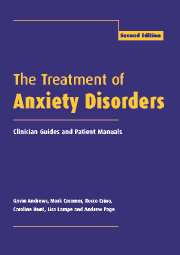Book contents
- Frontmatter
- Contents
- List of authors
- Preface to the second edition
- Abbreviations
- 1 Read me
- 2 General issues in anxiety disorders
- 3 General issues in treatment: Clinician Guide
- 4 Panic disorder and agoraphobia: Syndrome
- 5 Panic disorder and agoraphobia: Treatment
- 6 Panic disorder and agoraphobia: Clinician Guide
- 7 Panic disorder and agoraphobia: Patient Treatment Manual
- 8 Social phobia: Syndrome
- 9 Social phobia: Treatment
- 10 Social phobia: Clinician Guide
- 11 Social phobia: Patient Treatment Manual
- 12 Specific phobias: Syndrome
- 13 Specific phobias: Treatment
- 14 Specific phobias: Clinician Guide
- 15 Specific phobias: Patient Treatment Manual
- 16 Obsessive-compulsive disorder: Syndrome
- 17 Obsessive-compulsive disorder: Treatment
- 18 Obsessive-compulsive disorder: Clinician Guide
- 19 Obsessive-compulsive disorder: Patient Treatment Manual
- 20 Generalized anxiety disorder: Syndrome
- 21 Generalized anxiety disorder: Treatment
- 22 Generalized anxiety disorder: Clinician Guide
- 23 Generalized anxiety disorder: Patient Treatment Manual
- 24 Posttraumatic stress disorder: Syndrome
- 25 Posttraumatic stress disorder: Treatment
- 26 Posttraumatic stress disorder: Clinician Guide
- 27 Posttraumatic stress disorder: Patient Treatment Manual
- 28 Conclusions
- References
- Index
20 - Generalized anxiety disorder: Syndrome
Published online by Cambridge University Press: 05 August 2016
- Frontmatter
- Contents
- List of authors
- Preface to the second edition
- Abbreviations
- 1 Read me
- 2 General issues in anxiety disorders
- 3 General issues in treatment: Clinician Guide
- 4 Panic disorder and agoraphobia: Syndrome
- 5 Panic disorder and agoraphobia: Treatment
- 6 Panic disorder and agoraphobia: Clinician Guide
- 7 Panic disorder and agoraphobia: Patient Treatment Manual
- 8 Social phobia: Syndrome
- 9 Social phobia: Treatment
- 10 Social phobia: Clinician Guide
- 11 Social phobia: Patient Treatment Manual
- 12 Specific phobias: Syndrome
- 13 Specific phobias: Treatment
- 14 Specific phobias: Clinician Guide
- 15 Specific phobias: Patient Treatment Manual
- 16 Obsessive-compulsive disorder: Syndrome
- 17 Obsessive-compulsive disorder: Treatment
- 18 Obsessive-compulsive disorder: Clinician Guide
- 19 Obsessive-compulsive disorder: Patient Treatment Manual
- 20 Generalized anxiety disorder: Syndrome
- 21 Generalized anxiety disorder: Treatment
- 22 Generalized anxiety disorder: Clinician Guide
- 23 Generalized anxiety disorder: Patient Treatment Manual
- 24 Posttraumatic stress disorder: Syndrome
- 25 Posttraumatic stress disorder: Treatment
- 26 Posttraumatic stress disorder: Clinician Guide
- 27 Posttraumatic stress disorder: Patient Treatment Manual
- 28 Conclusions
- References
- Index
Summary
Recent population-based studies of generalized anxiety disorder (GAD) have shown it to be prevalent, chronic, and associated with significant disablement. Two surveys, the National Comorbidity Survey (NCS) in the USA using DSM-IIIR and ICD-10 diagnoses (fiittchen et al., 1995) and the National Survey of Mental Health and fiellbeing in Australia, using DSM-IV and ICD-10 diagnoses (Hunt et al., 2002) have provided the most recent and comprehensive information about the epidemiology of this disorder. Prevalence rates were found to be 1.6% for current GAD, 3.1% for 12-month, and 5.1% lifetime prevalence in the US population (fiittchen et al., 1994). GAD was shown to be a relatively rare current disorder but common if assessed over a person's lifetime. Lifetime prevalence rates were higher (8.9%) with the use of ICD-10 diagnostic criteria. In the Australian survey, the DSM-IV prevalence rates were 2.8% for 1 month and 3.6% for 12 months, somewhat lower than the ICD-10 rates of 3.6% for 1 month and 5.1% for 12 months (Hunt et al., 2002). These results provide somewhat lower lifetime prevalence rates as compared with earlier prevalence estimates using DSM-III diagnoses, possibly due to changes in the diagnostic criteria and differences in the study methods. For example, the Epidemiologic Catchment Area (ECA) study reported a lifetime prevalence of 4.1–6.6% in the three sites that assessed for GAD, but unlike the more recent surveys excluded cases with comorbid major depression or panic disorder (Blazer et al., 1991).
GAD is reported to be a common clinical diagnosis at the primary care level (Burvill, 1990;Goldberg and Lecrubier, 1995), yet it appears to be underrepresented at specialist treatment centers. The comparatively low proportion of individuals with GAD who present to specialist services may indicate that the majority of these individuals are not sufficiently distressed to seek specific treatment or may consider their anxiety as part of their nature and hence not amenable to treatment (Rapee, 1991b). Furthermore, individuals with GAD tend to present later for initial treatment in comparison with panic disorder sufferers (Nisita et al., 1990). There may also be a problem with a lack of recognition and slowness to refer at the primary care level.
- Type
- Chapter
- Information
- The Treatment of Anxiety DisordersClinician Guides and Patient Manuals, pp. 383 - 397Publisher: Cambridge University PressPrint publication year: 2002



